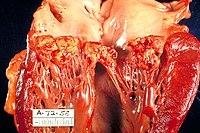
Photo from wikipedia
I read with interest the review by Fișuș and Findl on the prevention and management of capsular fibrosis [1]. Apart for small-sized capsulorhexis, IOL factors and pseudoexfoliation syndrome, I would… Click to show full abstract
I read with interest the review by Fișuș and Findl on the prevention and management of capsular fibrosis [1]. Apart for small-sized capsulorhexis, IOL factors and pseudoexfoliation syndrome, I would like to highlight two other important associations of anterior capsular contraction and phimosis, namely retinitis pigmentosa and zonular dehiscence [2–4]. In both of these instances, the capsular contraction can be severe and rapid [2], with onset as early as 4 weeks postoperatively and may result in significant loss of vision after an apparently successful cataract operation. These may occur despite an adequately sized capsulorhexis [3]. In patients with zonular dehiscence, the capsule may contract and cause subluxation of the implant in a direction opposite to the area of the zonular dehiscence. In the author’s experience, the phimosis and subluxation can be more severe when a capsular tension ring has not been inserted. In both instances, surgeons should consider carrying out radial relieving incisions of the anterior capsule at the end of lens implantation, to prevent the formation of a fibrotic purse-string. Alternatively, Nd:YAG laser should be applied to the edge of the anterior capsule [2, 3] preferably within four weeks of surgery and without the use of a contact lens.
Journal Title: Eye
Year Published: 2020
Link to full text (if available)
Share on Social Media: Sign Up to like & get
recommendations!